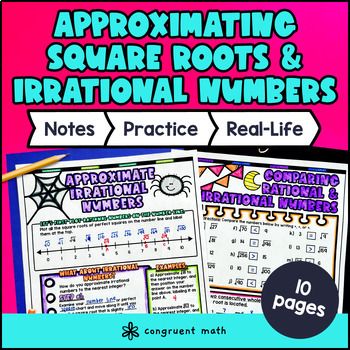Want more ideas and freebies?
Get my free resource library with digital & print activities—plus tips over email.
Join for Free Resources →
$4.25
Ever wondered how to teach approximate square roots and irrational numbers in an engaging way to your eighth-grade students?
In this lesson plan, students will learn about the concept of square roots and their real-life applications. Through artistic, interactive guided notes, checks for understanding, practice worksheets, and a color by number activity, students will gain a comprehensive understanding of approximate square roots and locating irrational numbers on the number line.
The lesson culminates with a real-life example that explores how these concepts can be applied to approximate pi and use it in calculations involving circles. This lesson is perfect for introducing the topic, reviewing or reteaching, homework assignments, sub plans, or quiz/test preparations. With its engaging activities and real-life connections, students will have an enjoyable and meaningful learning experience.

$4.25
After this lesson, students will be able to:
Before this lesson, students should be familiar with:
As a hook, ask students why it is important to approximate square roots and locate irrational numbers on a number line. Refer to the last page of the guided notes as well as the FAQs below for ideas.
Use the guided notes to introduce the concept of approximating square roots and locating irrational numbers on a number line. Walk through the key points of the topic, emphasizing the importance of understanding irrational numbers and their approximate values. Discuss the process of approximating square roots by finding perfect squares and using number lines. Refer to the FAQ below for a walk through on this, as well as ideas on how to respond to common student questions.
Based on student responses, reteach concepts that students need extra help with. If your class has a wide range of proficiency levels, you can pull out students for reteaching, and have more advanced students begin work on the practice exercises.
Have students practice approximating square roots and locating irrational numbers on the number line using the practice maze activity provided. Walk around the classroom to answer any student questions and provide guidance as needed.
Fast finishers can dive into the color by code activity for extra practice. You can assign this activity as homework for the remainder of the class.
Bring the class back together, and introduce the concept of using approximate square roots and irrational numbers to approximate the value of pi and use it for calculations involving circles. Refer to the FAQ for more ideas on how to teach it!
If you're looking for digital practice for approximating square roots and irrational numbers, try my Pixel Art activities in Google Sheets. Every answer is automatically checked, and correct answers unlock parts of a mystery picture. It's incredibly fun, and a powerful tool for differentiation.
Here are some activities to explore:
Square roots are the opposite of squaring a number. They help us find the number that, when multiplied by itself, gives us the original number. For example, the square root of 9 is 3, because 3 multiplied by itself equals 9.
In the context of real numbers, square roots are always positive or zero. This is because the square of a negative number is positive, and the square root is the reverse operation of squaring. However, in the context of complex numbers, square roots can be both positive and negative.
Approximating a square root means finding an estimate of the square root that is close to but not exactly equal to the actual value. This is helpful when dealing with irrational numbers, which cannot be expressed as a simple fraction or decimal.
There are several strategies for approximating square roots.
For students that need a visual example, this Khan Academy video can be helpful:
Irrational numbers are numbers that cannot be expressed as a simple fraction or decimal because they go on forever without repeating. Examples of irrational numbers include the square root of 2, pi, and the square root of 3.
To plot irrational numbers on a number line, you can make an estimate by finding whole numbers or fractions that the irrational number is between. Then, mark the approximate location on the number line. Keep in mind that the irrational number may fall between two whole numbers or fractions.
Approximating square roots is important because it gives us a way to work with irrational numbers, which are often encountered in real-world applications. It allows us to make estimates and calculations without needing to know the exact value of the square root.
Square roots have various applications in real-life situations, ranging from construction and engineering to finance and statistics. Here are some ways you can use square roots in real -life contexts:
Understanding how to calculate and apply square roots can help you solve problems more efficiently in these and many other real-life situations.
Get my free resource library with digital & print activities—plus tips over email.
Join for Free Resources →